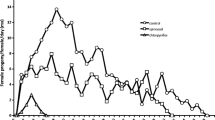Abstract
Knowledge of inter and intra-specific variation in the susceptibility of natural enemies to pesticides could help to better design integrated pest management strategies. The objective of this research was to evaluate the susceptibility to deltamethrin in populations of the predatory mites Neoseiulus californicus (McGregor) and Phytoseiulus macropilis (Banks) populations collected from protected ornamental crops in Brazil. The susceptibility to deltamethrin was characterized against immature and adult stages of both species. The impact of this insecticide was also measured by estimating the intrinsic rate of increase (r i). The immature and adult stages of N. californicus were approximately 3,600 and 3,000-fold more tolerant to deltamethrin than those of P. macropilis. However, high variability in the susceptibility to this insecticide was detected among P. macropilis populations, with resistance ratios of up to 3,500-fold. The selection of deltamethrin-resistant strains of P. macropilis could be exploited in applied biological control programs.

Similar content being viewed by others
References
Blommers LHM (1994) Integrated pest management in European apple orchards. Annu Rev Entomol 39:213–241
Bonafos R, Serrano E, Auger P, Kreiter S (2007) Resistance to deltamethrin, lambda-cyhalothrin and chlorpyriphos-ethyl in some populations of Typhlodromus pyri Scheuten and Amblyseius andersoni (Chant) (Acari: Phytoseiidae) from vineyards in south-west of France. Crop Prot 26:169–172
Croft BA (1990) Arthropod biological control agents and pesticides. Wiley Interscience, New York
Croft BA, Whalon ME (1982) Selective toxicity of pyrethroid insecticides to arthropod natural enemies and pests of agricultural crops. Entomophaga 27:3–21
Croft BA, Briozzo J, Carbonell JB (1976) Resistance to organophosphorous insecticides in a predaceous mite, Amblyseius chilenensis. J Econ Entomol 69:563–565
Georghiou GP, Lagunes-Tejeda A (1991) The occurrence of resistance to pesticides in arthropods. FAO, Rome
Gerson U, Smiley RL, Ochoa R (2003) Mites (acari) for pest control. Blackwell Science, Oxford
Hoy MA (1985) Integrated mite management for California almond orchards. In: Helle W, Sabelis MW (eds) Spider mites: their biology, natural enemies and control. Elsevier, Amsterdam, pp 299–310
Kogan M (1998) Integrated pest management: historical perspectives and contemporary developments. Annu Rev Entomol 43:243–270
Kostiainen T, Hoy MA (1994) Variability in resistance to organophosphorous insecticides in field-collected colonies of Amblyseius finlandicus (Oudemans) (Acari: Phytoseiidae). J Appl Entomol 117:370–379
Markwick NP (1986) Detecting variability and selecting for pesticide resistance in two species of phytoseiid mites. Entomophaga 31:225–236
McMurtry JA, Croft BA (1997) Life-styles of Phytoseiidae mites and their holes in biological control. Annu Rev Entomol 42:291–321
Oliveira H, Janssen A, Pallini A, Venzon M, Fadini M, Duarte V (2007) A phytoseiid predator from the tropics as potential biological control agent for the spider mite Tetranychus urticae Koch (Acari: Tetranychidae). Biol Control 42:105–109
Poletti M, Omoto C (2005) Variabilidades inter e intraespecífica na suscetibilidade de ácaros fitoseídeos à deltametrina em citros no Brasil. Man Integ Plagas Agroecol 75:32–37
Robertson JL, Preisler HK (1992) Pesticide bioassay with arthropods. CRC Press, Boca Raton
Rock GC (1979) Relative toxicity of two synthetics pyrethroids to a predator Amblyseius fallacis and its prey Tetranychus urticae. J Econ Entomol 72:293–294
Roush RT, Hoy MA (1980) Selection improves sevin resistance in spider mite predator. Calif Agric 34:11–14
SAS Institute Inc. (2000) SAS/STAT user’s guide, Version 8. SAS Institute, Cary, NC, USA
Sato ME, Silva M, Gonçalves LR, Souza Filho MF, Raga A (2002) Toxicidade diferencial de Agroquímicos a Neoseiulus californicus (McGregor) (Acari: Phytoseiidae) e Tetranychus urticae Koch (Acari: Tetranychidae) em Morangueiro. Neotr Entomol 31:449–456
Silva MZ, Sato ME, Oliveira CAL, Rais DS (2011) Toxicidade diferencial de agrotóxicos utilizados em citros para Neoseiulus californicus, Euseius concordis e Brevipalpus phoenicis. Bragantia 70:87–95
Software LeOra (1987) Polo-PC: a user`s guide to probit or logit analysis. LeOra Software, Berkeley
Stark JD, Banks JE (2003) Population-level effects of pesticides and other toxicants on arthropods. Annu Rev Entomol 49:505–519
Stark JD, Tanigoshi L, Bounfour M, Antonelli A (1997) Reproductive potential: its influence on the susceptibility of a species to pesticides. Ecotoxicol Environ Saf 37:273–279
Acknowledgments
We thank Mário E. Sato (Instituto Biológico, Campinas, São Paulo State, Brazil) for providing N. californicus population and Gilberto J. de Moraes (University of Sao Paulo, Piracicaba, São Paulo State, Brazil) for confirming the taxonomic identification of P. macropilis populations. We also thank Conselho Nacional de Desenvolvimento Científico e Tecnológico (CNPq) for providing scholarship and financial support for this research.
Author information
Authors and Affiliations
Corresponding author
Rights and permissions
About this article
Cite this article
Poletti, M., Omoto, C. Susceptibility to deltamethrin in the predatory mites Neoseiulus californicus and Phytoseiulus macropilis (Acari: Phytoseiidae) populations in protected ornamental crops in Brazil. Exp Appl Acarol 58, 385–393 (2012). https://doi.org/10.1007/s10493-012-9588-z
Received:
Accepted:
Published:
Issue Date:
DOI: https://doi.org/10.1007/s10493-012-9588-z




